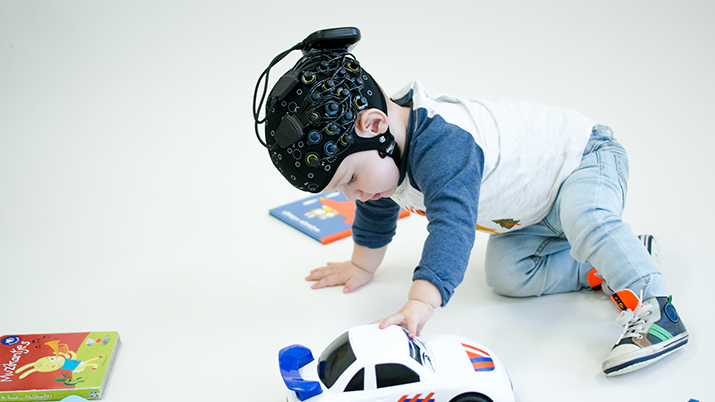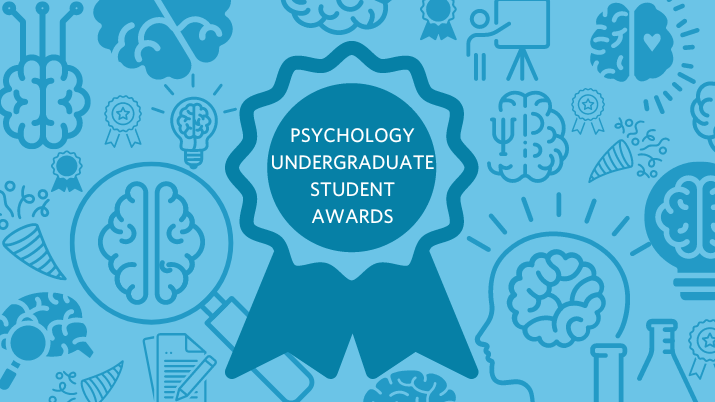

Toddler wearing the Brite fNIRS. Photo credit: Artinis
Dr. Maria Arredondo and Dr. Drew Weatherhead, postdoctoral researchers in the department of psychology at UBC, recently won the Artinis Win-A-Brite Contest for their pilot study proposal, What’s in a word? Imaging the birth of a word using fNIRS.
Toddlers are notoriously poor at sitting still and now, with the Artinis Brite Functional Near Infrared Spectroscopy (fNIRS) device, the researchers will get a glimpse in the brains of toddlers as they learn words.
Arredondo and Weatherhead work with Dr. Janet Werker in the Infant Studies Centre. Werker explores the foundations of language learning, including multi-language acquisition in infancy. Werker, co-investigator of the pilot research project, is interested in expanding her fNIRS work from infants to toddlers.
“The study could advance our understanding of the behavioural and neural mechanisms supporting word acquisition and bilingualism in children.”
“This pilot study is an exciting step,” says Werker, University Killam Professor and Canada Research Chair, Psychology. “We don’t know how the rapidly developing brain in young children is supporting word learning. The study could advance our understanding of the behavioural and neural mechanisms supporting word acquisition and bilingualism in children.”
fNIRS is an optical neuroimaging technique that provides a non-invasive measure of brain function—and the Brite is the world’s first wireless fNIRS portable device designed especially with young children in mind. Arredondo and Weatherhead plan to use it on toddlers to image the birth of a word in the pilot study, beginning in April 2019.
Most children at this age experience a “word spurt” that leads to large increases in their spoken vocabulary. As they get older and their vocabulary increases, their rate of learning new words also increases.
“There is very little research on how toddlers acquire new words during this vocabulary spurt—and how the brain accommodates it. Most toddlers are unable to sit still. With the Brite, the toddlers can explore their environment while allowing us to collect brain responses.”
Arredondo says there is a discrepancy in psychology and neuroimaging research showing whether toddlers are mapping and retaining new words. This first pilot study will help establish a link between behavioural and neural responses during word learning.
“The brain shows you something behaviour doesn’t allow you to see clearly,” says Arredondo, who researches how bilingual infants and children learn their languages. “We want to see what the brain looks like when kids successfully acquire a new word, versus those that may struggle. They may be learning a new word, but their behaviour may not be showing it.”
For Weatherhead, this pilot study is an exciting collaboration—and a chance to expand her research into the field of neuroscience. Her research focuses on how a speaker’s social characteristics, such as race and culture, influence speech processing in infants and toddlers.
Her previous research found that infants interpreted the same words differently depending on whether the speaker was from a racial group that was familiar or unfamiliar to them.
“The study will allow me to understand how children process unfamiliar words. And as time goes on, we could use this technology to study accented speech to see if children are processing accented pronunciations as familiar words—or if they think they are brand new words entirely.”
“Using neuroimaging opens new research questions for me,” says Weatherhead. “There is a lot of variation in the way we say words. Behavioural methods can only tell us how infants interpret words, not how they are initially processing them.”
Watch how comfortable the Brite is, even for babies.
“This research will be a game changer. It allows us to expand the field of word learning and word reference in this age group,” says Weatherhead. “I never thought I’d be able to do this research because at this age, children don’t like to sit still.”
How the study works
For the pilot study, the researchers will test 40 English-exposed toddlers (28- to 32-months-olds) using the Brite fNIRS and an eye tracker to record the children’s looking behaviour. In a 7-minute session, children will complete an indirect word-learning task, where children are simultaneously presented with a familiar (e.g., a car) and novel object. In Familiar trials, they will hear a label along with the familiar word (“Look at the car”). In Unfamiliar trials, they will hear an unfamiliar word (e.g., “Look at the blicket”). Successful word learning is inferred if, in the unfamiliar condition, children look longer to the novel object. Next, children will be presented with a short delay where they will watch a cartoon. After the delay, children’s retention of the indirectly learned words will be assessed with trials that contain each of the novel label-object pairs previously learned in the Unfamiliar trials. Children’s looking time toward the target object will be analyzed and related to their brain response.
Join the study
Parents interested in taking part can contact the Infant Studies Centre directly by phone at 604-822-6408 or by email at infants@psych.ubc.ca.


